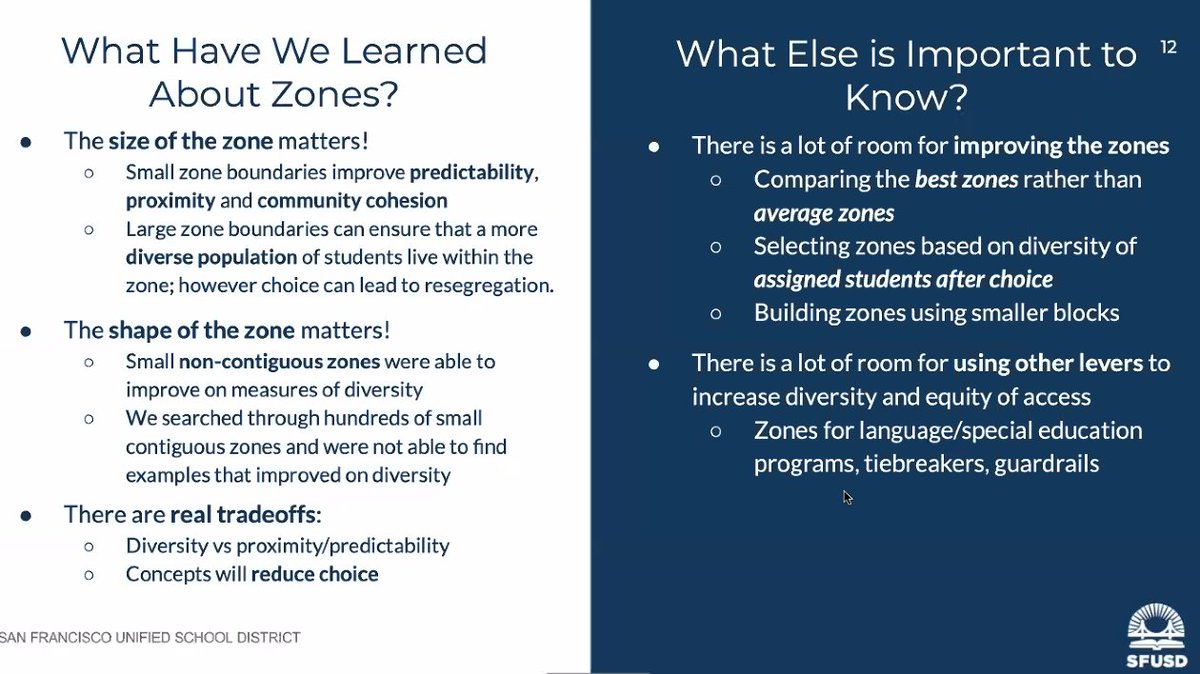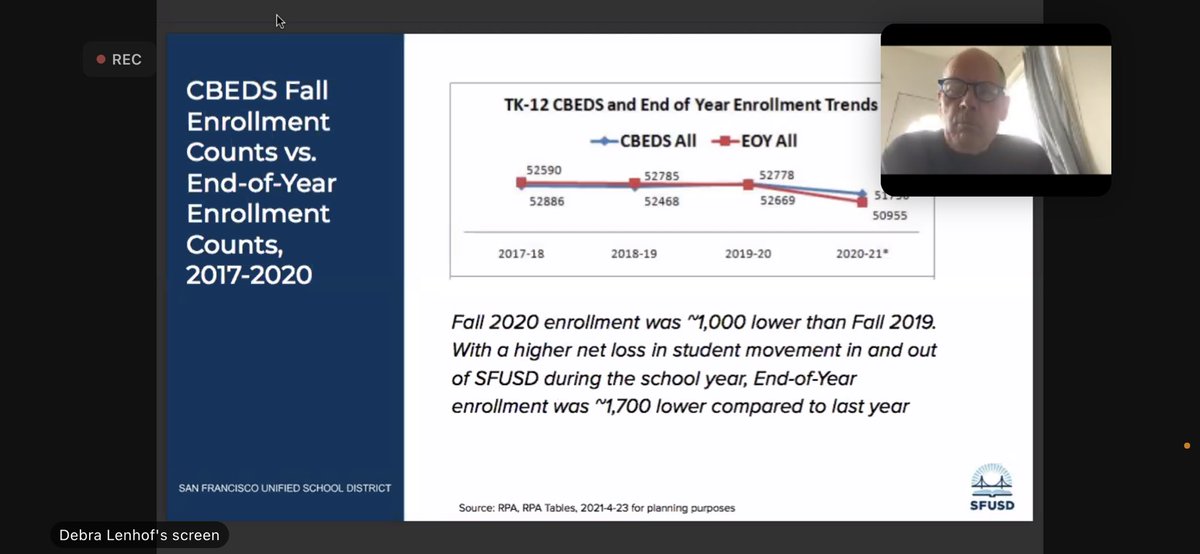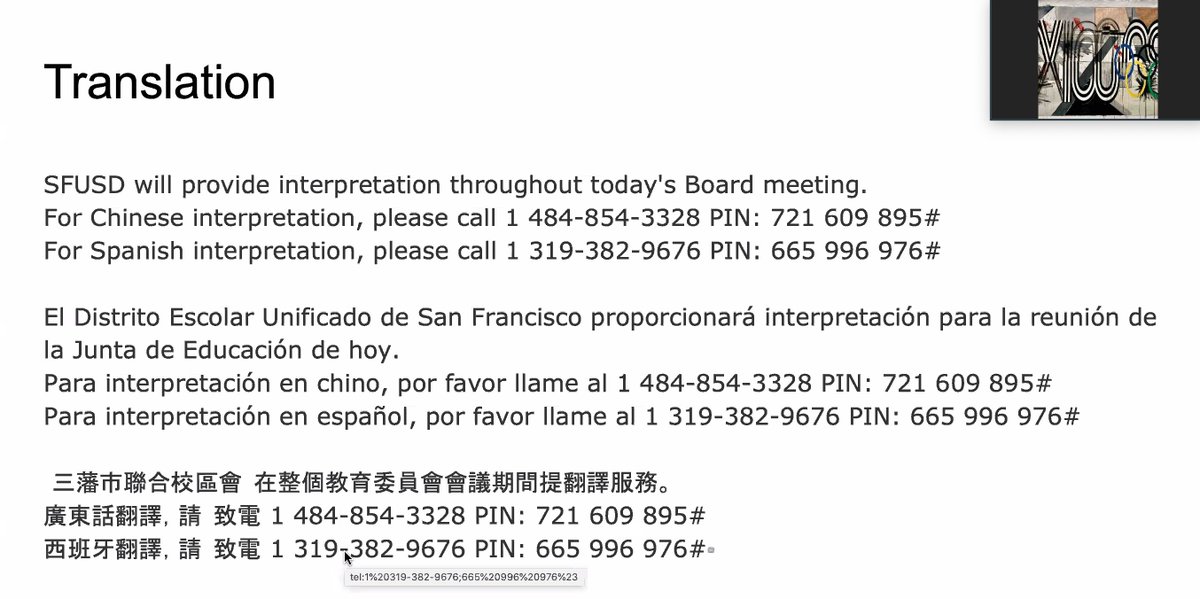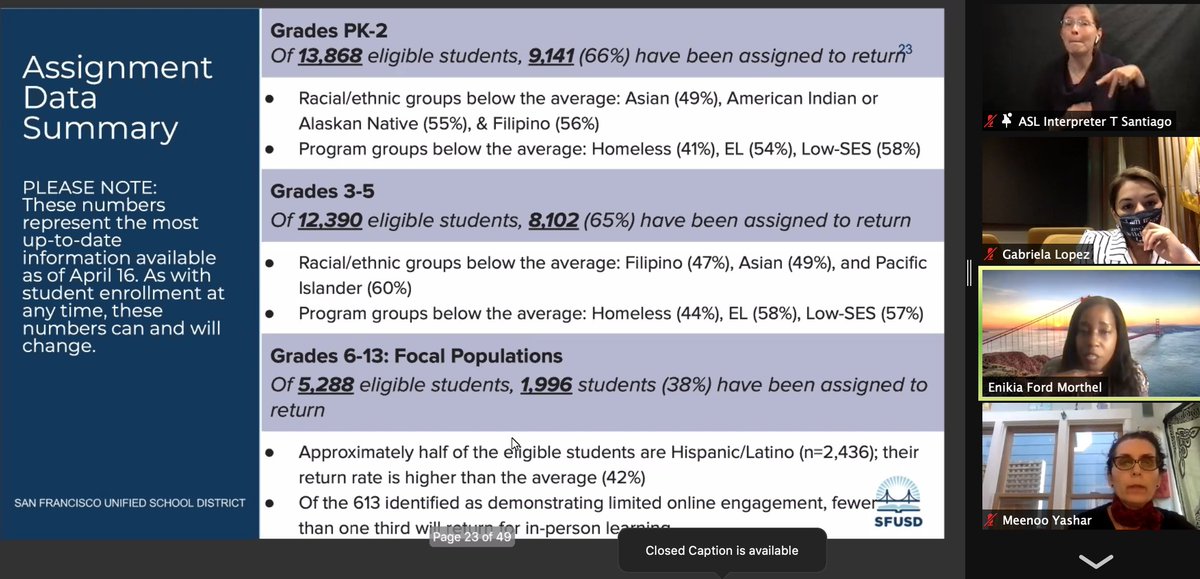Starting with the presentation from staff on policy on new student assignment policy for elementary schools. Presentation: drive.google.com/file/d/19UQTnv…
Heard from the board that we need to be willing to modify boundaries over time in order to achieve diversity goals. #BoardWatch
Believe there are ways to develop a policy that is simple for families, even if "under the hood" it is complex. #BoardWatch 

Took option 1 off the table, tonight not talking about size of zones but how they would work. Will focus on "guardrails" and "tiebreakers" #BoardWatch 



Hope that by the end of tonight will have guidance to inform a policy recommendation at the next meeting. #BoardWatch 

Now starting to talk about policy simulations. First "chapter is about "zone boundaries." Here is some summary information about Zones #BoardWatch 

There are tradeoffs in drawing boundaries between diversity, proximity and predictability. Lots of room for improving zones from the way they are. #BoardWatch
Case study from Berkeley Unified: they use zones drawn very intentionally do include different income demographics. All children guaranteed a seat at a school in zone #BoardWatch 

In SFUSD there are many programs that don't have tiebreakers for living nearby. Could incorporate them into the zones, but would have to move or replicate programs #BoardWatch 



Third option: create different sets of zones for unique programs.#BoardWatch 

Here is a summary of some of the advantages of drawing different zones for different kinds of programs. #BoardWatch 

Here is ALL of the different programs in SFUSD #BoardWatch 

This is how this might look. Sounds complicated, but staff assures it is only complicated "behind the scenes." Families don't have to look "under the hood" #BoardWatch 



Based on where you live, can see a list of all general ed programs, older sibling school, and also all the language pathways that can accomodate english speakers (if you are an english speaker) Slide shows what it would look like if child received SPED and EL services #BoardWatch 

Lots of academics and researchers have helped with this policy and running simulations! #BoardWatch 

Professor Lo is talking about the simulations. First looking at concept number 3 to see if it is possible to restrict choice within zones. #BoardWatch 

This is how the language and special education zones were created #BoardWatch 

Questions: is concept 3 feasible? Here is what the researchers say. #BoardWatch 

To make concept 3 feasible, would need to assign many more students to schools that are currently under-enrolled and provide resources to grow these schools. #BoardWatch
What is effect of restricting choice? #BoardWatch 

Once metric they are looking at is called "block group cohesion" - number of students assigned to a school with at least 3 other students from their block. #BoardWatch
Staff wants to know what the board things about making different zones for GE, Special ED, and Language programs? Now moving to talk about Guardrails- which seats filled by which students: #BoardWatch
Strategy to prevent resegregation through choice process. Unconstrained choice leads to segregation historically. #BoardWatch 

Here is an example of how this works in Berkeley. #BoardWatch 

Does this work? Unequivocal yes. Here is the data. #BoardWatch 

Here is how they simulated guardrails in SFUSD #BoardWatch 

Ran simulations for different possible zone maps, with and without guardrails. Guardrails increase diversity, but decrease proximity, predictability, and choice. #BoardWatch 

Proximity metric: percent of students who travel less than half mile to school. This percent was 34% in 2018/19, if restrict choice to zones increases up to 41%, if introduce guardrails, drops as low as 30% #BoardWatch 

Both restricting to zones and using guardrails disrupts historical choice patterns. Decreases % of students receiving first choice. #BoardWatch 

"There will be a felt difference from the family perspective" says Professor Lo. #BoardWatch
Choice reduced for all, but reduced less for focal populations under this system. #BoardWatch
Using conservative estimates, so this is the "worst case scenario" for impact on choice. #BoardWatch
Need buy-in from district and public for guardrails to work. #BoardWatch 

In other words, people actually have to enroll in the assigned schools #BoardWatch
Another question for the board: what do you think of using guardrails to prevent self-segregation? #BoardWatch 

Now moving on to talk about tie-breakers (if you have ever been through the SFUSD lottery, you should know what these are) #BoardWatch 



Tiebreakers not most effective to meet goals, but can improve choice for students who receive them. Here are the ones staff are considering keeping. See them as values statements. #BoardWatch 



Now the staff is going to put it all together! This slide shows one version of how this could look. #BoardWatch 

Here are some potential outcomes of this system. "Hellinger" is a measure of ethnic diversity, not performing as well. #BoardWatch 

There is an appendix to the slides with data for large contiguous zones and small contiguous zones (this shows medium). There are tradeoffs for each size #BoardWatch. (Not sure if we have access to appendix)
Here is a slide comparing different tradeoffs: goals being met under different systems #BoardWatch 

"Designated" means those assigned to a school they didn't request, this would go down in medium zones, and increase a bit when add guardrails. #BoardWatch
"Hellinger" and "Thiel" are both measures of diversity. Zero means a school resembles ethnic makeup of district. 1 means "way off" #BoardWatch
Last (bottom of chart) measure is how many schools are within 15% of the district average for % of students eligible for free and reduced lunch. #BoardWatch 

Here are key takeaways: there will be a period of disruption, but it will be "ok on the other side." Assignment policy alone cannot assure integration, need investment in schools, transportation, marketing, etc. #BoardWatch 

Three discussion prompts for the board #BoardWatch 

Shifting gears: here are some updates on other improvements recommended related to assignment. First on transport, recommend not stopping at every school. Shifts in transport will be key to this system.#BoardWatch 

Predictability makes it easier to design efficient transport routes that save money. #BoardWatch
Here is the policy development timeline. Will be back on the 14th of October at 5PM with draft recommendation. #BoardWatch
Many inputs to determine policy outcome. There are massive tradeoffs (slide 46). #BoardWatch 

Commissioner Norton "wow, that was a lot!" Moving to public comment first. Sorry that we might miss some of debate. Five speakers signed up, limiting comment to 15 minutes. @rpnorton #BoardWatch
First comment: encouraged by emphasis that the assignment system wont fix the real areas of concern. Joint advisory council report did not reflect that first priority was choice. Reflects that families first and foremost concerned with quality of schools and resources.
Comment cont: meaningful community engagement has been difficult to achieve in the timeline the board has created. #BoardWatch
Comment: not always home address that matters for proximity, sometimes caregivers or workplace, or afterschool program. Also transportation has to include public transit. Current map is inequitable. #BoardWatch
Comment Cont: consider redlining - keeps the poor in poor neighborhoods #BoardWatch
Comment: understand bussing will be crucial to several proposed options, but need to think about funding. Have had budget cuts and other funding struggles. Bussing is expensive.#BoardWatch
Comment: concerned that we are going from complex to incredibly complex. Have attended most of these meetings and struggle to understand. Not clear how zones would be designed as demographics change. What if prop 16 passes and we could use race as criteria? #BoardWatch
Comment cont. Have concern that students will only have access to programs in their own language. Example: in my school students who speak many languages have access to Arabic language #BoardWatch
Comment: appreciate the amount of data. Head is spinning. Big question. We are talking about a first reading of a new proposal going to the board in less than a month. Planning to take to parents, need to be transparent and nobody understands this #BoardWatch
Comment cont: really worried about family engagement via Zoom. Last year folks said it was hard to give feedback without details, now we are going to try to give the details and get feedback in a couple of meetings? #BoardWatch
Comment: concerned about presenting this to families in a way that is simple. Some families do not speak english, families of students in special education need to understand where they fall (what is sped1-sped7?)Bussing, need to be cautious about who this effects #BoardWatch
Comment is over, moving to commissioner questions. Commissioner Sanchez: how is this working in Berkeley, with the guardrails. A: What we simulated is meant to mimic what they are doing. Berkeley has been fairly successful at integrating schools going back to the 60s. #BoardWatch
Sanchez: is the percentage indicator for ethnic isolation 50%. Henry O'Connell: it use to be 60% and before that 45%, just picked 50% for this. Sanchez: does this take into account seats at schools currently occupied by charter schools? A: assumed no charters there #BoardWatch
Sanchez: it would be hard for us to move all those charter schools, need to have that conversation at some point. Cook: can you clarify what special ed 1-7 on slide 26 means? #BoardWatch
There was an answer to this but I don't understand... #BoardWatch
I think that each number is a different simulation - different ways of drawing special ed zones. Seven different ways of drawing zones. (Thanks @rpnorton for clarifying understanding) #BoardWatch
Commissioner Norton: On slides 33-35 about guardrails. Now, what percentage of K students are designated to a school they didn't choose. A: between 11-12% #BoardWatch
Norton: very concerned about what happens if families opt out. What percentage now participate in first round but don't enroll. A: 4-5% (350 students get first choice and drop out) a total of 1000 or 20% don't attend. #BoardWatch
Norton: what if 20% drop out? A: look at where people drop out geographically, if 20% still drop out, won't need more seats as anticipated. Lo: dropout will depend on choices available to family and we don't have data on that. Have some models-havn't run on diversity outcomes
Norton: pull slides 33 and 34. Got really confused on this. Asking for Professor Lo to describe again. Columns are different metrics, rows are performance of different size zones, with or without guardrails. #BoardWatch 

Where are the benchmarks? A: The last row in the column Q: Does darker green mean better in terms of the metric? A: Yes, green is best, white is worst #BoardWatch
Q: is the staff looking at medium contiguous zones as being the best? A: yes, with guardrails. Guardrails and how zones drawn is more important than size #BoardWatch
Answer continued: selected medium contiguous zones because they performed well on all measures and look more reasonable than some options #BoardWatch
Norton: can you talk about how these indicators might change if you used smaller geographic blocks to put together zones? A: we built the machinery but didn't have time to play with it. The more we can "break the puzzle" the more we can create more diverse zones #BoardWatch
Now commissioners need to give feedback on the three questions from the staff. Feedback on timeline, community engagement, simplicity etc. #BoardWatch
Sanchez: take to heart feedback about complexity, I had a preview and understand more now. Want to have a robust community forum as we have changed the notion of what the assignment system will look like. Still committed to getting this done #BoardWatch
President Sanchez: support the different zones for GE, Language and Special Education. Cook: OK with different zones, need to better understand guardrails, tiebreakers sound reasonable. Want people in public housing to have a great option near them (2000 students) #BoardWatch
Commissioner Lam: How does creating different zones make things more simplistic for families? Trying to make system less complex. Find this very complex. #BoardWatch
Chief O'Keefe: Language pathways are not distributed evenly throughout the city. Made it impossible to draw zones that gave equal access to programs. Slide 19 shows the "under the hood" Slide 20 shows what parents would see. It would show you what schools you could choose from.
The yellow dots on this map show the programs you have access to based on where you live, grade, home language, IEP, and sibling status, then you get list of choices 

Professor Ashlagi: Will need to rank from less programs. Don't have to choose from whole city. Will be same assignment algorithm as now, possibly different priorities for assignment #BoardWatch
Norton: IEP process is always going to drive placement and some will be placed outside of process, but like that they a special ed process based on where they live. What about K-8 schools? #BoardWatch
Two options K-8s that are language programs would be in the language system, other K-8s treated as "neighborhood" or they could be a separate zone overlay. #BoardWatch
Now talking about guardrails: Cook has offline questions, Sanchez approves of them, Lam has questions about transportation. When does transportation conversation come into play? O'Keefe: already starting to look at different options. More predictable = easier for transit systems.
O'Keefe says also looking at muni. Lam notes that even though her school was 1.5 miles from home, would have to take 2 busses, need to look at these things #BoardWatch
Norton: need to remember that Berkeley USD is 40% white and SFUSD is 10% white. Berkeley USD is more affluent and less diverse that SFUSD. Families of means tend to opt out of our system, may still leave some kids behind and have worse outcomes as far as isolation. #BoardWatch
Norton: why are we suggesting guardrails? Could result in nobody getting what we want, but the system looks more diverse, and those with means likely to opt out. #BoardWatch
O'Keefe: need to own the narrative and be really aware of what we are trying to accomplish. It will be difficult. Current state is primarily reflection of families desire, result has been racial isolation and under-enrolled schools #BoardWatch
O'Keefe: have been saying since the beginning that this would be incredibly disruptive #BoardWatch
O'Connell: have seen through decades of observation and running scenarios, choice is at odds with diversity. Implicit bias and other reasons. To disrupt this students will be assigned to schools that are not their first choice. #BoardWatch
Sanchez: the guardrails are reminiscent of the "diversity index" (prior assignment system) unlike choice system you don't have to opt in to benefit. #BoardWatch
Norton: moving on to tiebreakers. In general think they are appropriate. Seems to be concensus on this. Sanchez: what about community engagement? #BoardWatch
O'Keefe: discussions have started around outreach, feedback is as reflected in public comment tonight. Window of opportunity in October/Nov is to inform community of what is being presented to board. Not for them to vote on it. #BoardWatch
O'Keefe: Other goal is to get feedback on what will look like to have authentic engagement as the zones are being designed as well as transportation infrastructure. This will happen after board has approved policy. #BoardWatch
Norton: addressing the public. Part of the complexity would not be in the final proposal, it is in the process by which different scenarios were run. Real complexity is in building the implementation. #BoardWatch
Norton: should build in ongoing meetings of the committee to monitor, some structure to monitor and assess that is funded. That is lesson we learned last time. Built monitoring in, but didn't have resources to do it. Maybe look at having Stanford give a report every year.
Norton: timeline is tight, but have been discussing it for a year and have affirmed this timeline many times. I think we should push on. #BoardWatch
Lam: when can we articulate back out to the public what the timeline for community engagement will be? O'Keefe, will provide an update before the 14th, and more detail on the 14th. Norton: post updates on student assignment site. #BoardWatch
O'Connell: 4 dates selected 10/27.28.29 and also at the enrollment fair on Nov 7th. The first three will be language specific. Some info on the website. #BoardWatch
Lam: need to start figuring out who can cohost these. O'Keefe: the team that has been leading this has been engaging with community groups, that is what you were hearing in the comment is their concern after these conversations #BoardWatch
Professor Lo: on the timeline. This is a very ambitious timeline, district staff and consultants have been working long hours. Think this timeline is very ambitious and more leeway would help. Have experience in other districts #BoardWatch
Commissioner Norton adjourned the meeting. See you next time. #BoardWatch
@threadreaderapp unroll
• • •
Missing some Tweet in this thread? You can try to
force a refresh












